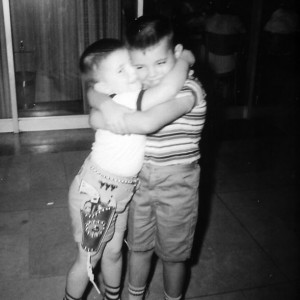This month, many of us in Pagan communities have been wrestling with the issue of sexual abuse. Much as we’d like to think that we have healthier attitudes toward sexuality than the wider culture in which we live, the reality is that sexual abuse is endemic in our society, and our communities are no exception.
I urge you to read Cat Chapin-Bishop’s recommendations as to how communities can constructively respond to abuse. Cat specialized in the treatment of sexual abuse survivors for twenty years, and hers is the most comprehensive, cogent, and compassionate framing of the issue that I’ve seen. I hope leaders will return to her article again and again as they revise or draft policies around sexual abuse response for their groups and events.
My own contribution to these discussions is about creating a Pagan culture that not only helps to prevent inappropriate and abusive touch, but encourages loving, consensual touch. I want Pagan events to embody consent culture. In my last post on this topic, I outlined ethical principles that ground my understanding of consent culture. Here, though, I want to deal with simple ways to put these principles into practice.
What is consent culture?
Urban Dictionary has a great off-the-cuff definition:
A consent culture is one in which the prevailing narrative of sex is centered around mutual consent. It is a culture with an abhorrence of forcing anyone into anything, a respect for the absolute necessity of bodily autonomy, a culture that believes that a person is always the best judge of their own wants and needs.
A consent culture is also one in which mutual consent is part of social life as well. Don’t want to talk to someone? You don’t have to. Don’t want a hug? That’s okay, no hug then. Don’t want to try the fish? That’s fine. Don’t want to be tickled or noogied? Then it’s not funny to chase you down and do it anyway.
How do we create consent culture?
I’m going to start with some simple, concrete recommendations. These are meant to be starting places to explore how you might build consent culture in your group or community, however, not stopping places. Building consent culture involves confronting issues of power and vulnerability. It requires that both the initiators and receivers of touch improve their communication and listening skills. It calls us to deepen our empathy and bring mindfulness to all our interactions. A blog post can only scratch the surface of these issues – but it gives us a place to begin (and I hope you’ll follow some of the links at the bottom in order to go deeper).
The basic practice of consent culture is to ask and get consent before you touch. Among people we don’t know well, asking verbally is a good idea, i.e. “May I hug you?” In many cases, however, a nonverbal ask works just as well: you can open your arms for a hug and wait for the other person to mirror the gesture before hugging them. Note that asking is only half of the procedure; waiting for the enthusiastic “YES!” is the other half! A non-enthusiastic “yes” is usually a “no” in disguise.
To build consent culture in communities, train your leaders to model consensual behavior for others. Consider a leadership training where participants practice asking and getting consent; politely but firmly saying no to touch; and gracefully taking no for an answer. Leaders might also practice recognizing body language that signals less-than-enthusiastic consent, as with guests who accept touch they don’t want out of a sense of peer pressure. Create strategies for giving guests who don’t know the expectations of the group socially appropriate outs: for instance, asking, “Do you hug, or do you prefer the handshake?” or explicitly telling a newcomer, “People here like to give hugs, but if you’d rather not do that, just offer your hand instead.” (People who have chronic pain or similar conditions may need more complex negotiations to engage in affectionate touch; see this article by Staśa Morgan-Appel for strategies.)
 Consent culture should make it easy (or at least easier!) to say yes or no. Many people struggle to be explicit about their desire for touch or their discomfort with it. At events, basic consent to touch can be made easy with wearable, colored “hug codes.” Provide green, yellow, and red stickers that can be applied to nametags, along with a flyer or other materials explaining their meaning: Green means “Hug me,” yellow means “Ask me if I want a hug,” and red means “No hugs please.” The accompanying materials should note, however, that permission to hug doesn’t mean automatic consent to other kinds of touch, and that permission can be withdrawn verbally at any time. The “Hug Code” information sheet can also be used to educate attendees about appropriate behavior around touch in general at the event and advertise workshops or orientation sessions that cover consent culture, safer sex, etc.
Consent culture should make it easy (or at least easier!) to say yes or no. Many people struggle to be explicit about their desire for touch or their discomfort with it. At events, basic consent to touch can be made easy with wearable, colored “hug codes.” Provide green, yellow, and red stickers that can be applied to nametags, along with a flyer or other materials explaining their meaning: Green means “Hug me,” yellow means “Ask me if I want a hug,” and red means “No hugs please.” The accompanying materials should note, however, that permission to hug doesn’t mean automatic consent to other kinds of touch, and that permission can be withdrawn verbally at any time. The “Hug Code” information sheet can also be used to educate attendees about appropriate behavior around touch in general at the event and advertise workshops or orientation sessions that cover consent culture, safer sex, etc.
Consent culture starts with kids. Kids who grow up believing that they and others have the right to control their own bodies are better-equipped to initiate respectful touch, to clearly say yes or no when touch is offered, and to interfere when they see someone else being violated.
Here’s a simple game that you can play with elementary-aged and older children. Not only does it teach consent and empathy, but it’s a lot of fun and great for making friends! Adults should be present to model the game, make sure the rules are being followed, and insure safety, as children playing this game can easily become rambunctious.
- Break into pairs.
- In each pair, one child asks his or her partner if s/he can touch them in a specific way. “Can I give you a hug?” “Can I tickle your ribs?” “Can I grab you and spin you around?”
- If the partner wants to be touched that way, s/he says, “YES, YES, YES!” and participates in the touch.
- If the partner does not want to be touched that way, s/he says, “No thanks!” or “Not today!”
- If the partner refuses the touch, the child initiating the touch must do his/her best to perform the action on him/herself. This can result in some hilarious attempts at self-tickling, self-noogie-ing, etc.
- The children switch roles. Now the second child offers a touch, and the first child can accept or decline.
- Remind the participants that they can switch their answer from yes or no, or from no to yes, even after the touch has begun. Children may enjoy having the adults model this lesson in a silly way (“Hug! Stop! Hug! Stop!”) while still driving home the importance of permission to touch.
- Children who fail to wait for a “yes” must wait out a round before rejoining the game. (It’s useful to have an extra adult to step in as a partner when a child goes out for a round.)
- Children should switch partners every round or two. The game facilitators can also experiment with phrasing the offers of touch differently (“Can I have a hug?” “Will you tickle me?” “Will you grab me and spin me around?”) or including affectionate gestures that don’t include touching (“Can I blow you a kiss?”). For an additional variation, give each child a sticker or other small reward every time they complete a round while following the rules.

This game provides wonderful opportunities for discussion. How does it feel to say “No thanks,” or to be told “No thanks”? How does it feel to say “YES”? What kinds of touch were really fun? Did anyone say yes to a touch that turned out not to be fun? What did they do, and what did their partner do? Did anyone say “no” and then change their mind? What was that like? What was it like for their partner?
Adults will find that, especially if played with older children or adolescents, the game provides many opportunities for children to experience both positive and difficult emotions. It may be worthwhile to stop to talk in the middle of the game: Does your partner’s “no” feel like being rejected? How does it feel to say “no” back? How does it feel to say “yes” if your partner keeps saying “no”? How does it feel to say “no” if your partner keeps saying yes? Did anyone say “yes” because they were afraid of hurting a partner’s feelings? Participants can use these discussions as opportunities to talk about how to respect a “no” by not taking it personally and how to find kinds of touch that both participants will find fun.
Unless the participants are already part of a group where physical, group-bonding games are played regularly, the game facilitators should inform the children’s parents before playing this game. Note that some younger children may struggle with the rules of the game. Children who have difficulty keeping their hands to themselves, however, may be the ones who benefit the most from learning how to explicitly ask for touch; their tendency to harass or tease others may be the only way they know how to get the contact they want.
Want to learn more about creating Pagan consent culture? Here’s some additional reading:
Some Experiences with a Culture of Consent and Radical Inclusion
Yes Means Yes!: Visions of Female Sexual Power and a World without Rape
Eros and Touch from a Pagan Perspective (introduction) (full book)
















